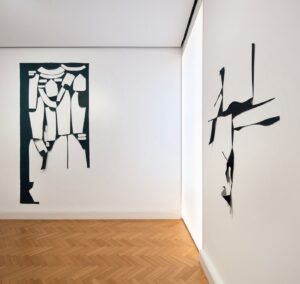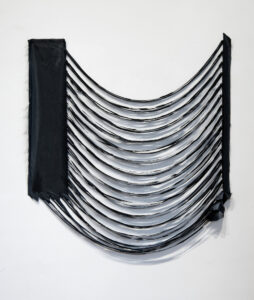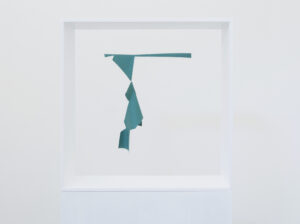We are absorbed in a hyper-connected and hyper-speeded world, human is fulfilled with information and most recent news. Thus, if we live reality, it’s only as a function for a future, according to the desire for ever greater capitalization. According to this economically oriented direction, past is old and out of fashion, conceived as something that has no longer anything to teach us. Viasaterna exhibits a witness to this heritage: Marion Baruch. She wants to show us what we are forgetting: we are children of history, but above all of being empty, wounded by our own history, which it cut with everything that preceded us.

Installation view of Marion Baruch solo show at Viasaterna, ph courtesy Viasaterna, Milano
Marion Baruch is a cosmopolitan artist. Throughout her life she often changed countries and cities, starting from Timisoara, Bucharest, Jerusalem, Rome, Paris and finally Gallarate. Thanks to her numerous travels, the artist has been able to encounter various traditions and cultures, which she celebrated in the choice of titles of her works, using all the languages she learned in her migrations. She was born at the end of the 1920s and found herself witnessing the developments of the last century: starting from the affirmation of ideas to the consequent fall of great narratives and, finally, the Economic Boom, with its consequent capitalist dictatorship. Within Marion Baruch’s recent artistic production, the traits of these wounds emerge, from which the orphanage of the past artistic tradition is evident. Viasaterna exhibits the latest works by the artist who, having settled permanently in Gallarate, focuses above all on the reuse of waste from the textile industry, raising awareness of environmental issue. The material used is full of history. When at the beginning of the last century women began to make their voices heard and claim their rights, the lucky few who could afford to deal with artistic matters were the wives or partners of established artists. This is the story of Sonia Terk Delaunay, who made a traditionally feminine job (sewing) the technique to create her own art works. She sewed scraps of fabric to create cubist-orphic compositions, as the movement’s name whose husband was the leader of. The tradition of fabric and sewing for proto-feminist artists was an element of study and political claim. They made the stereotype attributed to them their emancipated signature.

Marion Baruch, “Schwerkraft”, 2018, polyester, 118 x 94 cm, ph courtesy Viasaterna, Milano
Marion Baruch uses textile material in her work to look at the entire contemporary art history. She displays the leftovers of pret-à-porter packaging, waste of fabric that the industry would throw away. The artist sacralizes and chooses these leftovers using the process introduced by Duchamp, who subverted the visual categories to redefine the concept of the artist, who isn’t someone who represents reality through a refined technique, but is someone who indicates, someone who selects a detail of reality, triggering a re-signification of the common object. Rosalind Krauss, American art critic, in relation to Duchamp’s poetics broadens the concept of “indexicality”: she doesn’t limit it only to the gesture of the artist who focus on an object, but also places this thought within the visual experience, so that it can be there a trace of something that has been, the memory of an event. For example, the sign left by the coffee cup on the table or the black streaks of car tires on the road. Baruch’s fabrics are in this path, chosen and exhibited no more as waste but as marks that remains of something that has been, signs of a work that it’s over now. The work “Infinito” takes the form of a figure that remains of a totem. The large rolls of fabric keep their external rectangular shape and, once applied to the wall, loom over the spectators, resembling giants monoliths of shaped fabric. They are looming presences filled with voids. The massive appearance recalls some compositions of objects by Louise Nevelson, an American artist famous mainly for her monochrome wooden assemblages from the 1960s, entitled “Sky Cathedral Presence”. She, as Marion Baruch, worked on the contrast of full and empty, of light and shadow; however, the Romanian artist tends to minimize the intervention, restrict herself to the choice of the object and not to its manufacture, thus increasing the power and the dialectic between full and empty which remain so.

Marion Baruch, “Precision mechanism for sculptures”, 2023, cotton satin, 60 x 60 x 15 cm, ph courtesy Viasaterna, Milano
However, we must still ask ourselves a major question: what is the subject of these works? In Marion’s ready made, which would be more correct to call ready-cut, the contrast between presence and absence creates shadows that draw pictorial effects on the white wall, thanks to the lighting of the Viasaterna space. These nuances seem like a real photograph, a writing with light, as it is clear above all in the work “Schwerkraft”. The subject, therefore, is the void filled with shadows, which gives it depth. Marion Baruch’s fabrics were installed in the Viasaterna exhibition spaces in a way that show their weight, the precise lines of the industrial cuts are modified and curved by the force of gravity. Even the American sculptor Robert Morris, when he worked with felt, chose to use the force of gravity as a real material to create his works. Following Robert Morris’ flow, Baruch proposes a reflection on the potential of the fabric itself. This research follows the way of Process Art, an artistic trend from the late sixties, which, as the name suggests, focused on the process of creating. The meaning of the work consisted in the practice. Marion Baruch doesn’t limit herself only to show the weight and the powers of the fabric, she also speaks of another process, the industrial work, of which she exposes the waste, shows what remains, what is hidden and not worn. The thought that the artist applies on the force of gravity is also visible in the triptych of works titled “Precision mechanism for sculptures”. A small rag of fabric hangs in a display case from the two upper ends. The power of these works consists in that small point where the fabric is about to tear apart irreparably but a thin thread supports the lower end which is about to tear up to the force that drags it towards the ground. From these works the relevance of the artist’s research is evident: today we are hanging, we experience a sense of precariousness, but this sensation is overwhelmed by the noise that man creates so as not to hear it. Marion’s paintings show human and his history in the twentieth century, pierced and torn by the terrible events that happened and marked the rhythm of those years. Events that have opened cuts and wounds in contemporary people that don’t seem to be able to be filled, Marion Baruch’s work proposes to do so with a shadow. Luckily, today there is someone who isn’t afraid of the void.
Pietro Coppi
Info:
Marion Baruch – Solo Show
31/01 – 22/03/2024
VIASATERNA
Via Giacomo Leopardi 32, Milano
viasaterna.com

is a contemporary art magazine since 1980






NO COMMENT